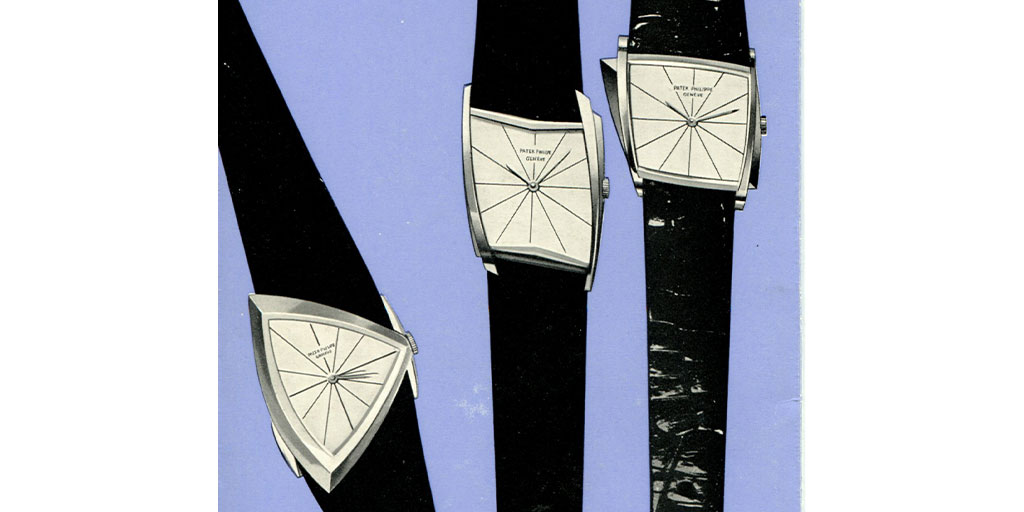Names such as ‘Ricochet’, ‘Flying Saucer’, ‘Asymétrie’, ‘Futuriste’ and ‘Tutti Fruitti’ are not normally associated with iconic Patek Philippe watch designs, but in the world of timepieces designed and crafted by the genius hands of Gilbert Albert, they are sought after by both connoisseurs and museums alike.

Born in Geneva in 1930, Gilbert Albert always had a love of nature and its influence on design. His father encouraged this love alongside the study of entomology which would later inform much of his work. His prodigious talent was recognized at an early age, and at 15 years old he attended the l’Ecole des Arts Industriels in Geneva. Here he was able to explore all aspects of design and develop his love of modern sculpture and his admiration for artists such as Brancusi and Mondrian. Most importantly, he learnt to follow his college tutor’s advice that “if you want to succeed, do what others will not do”.
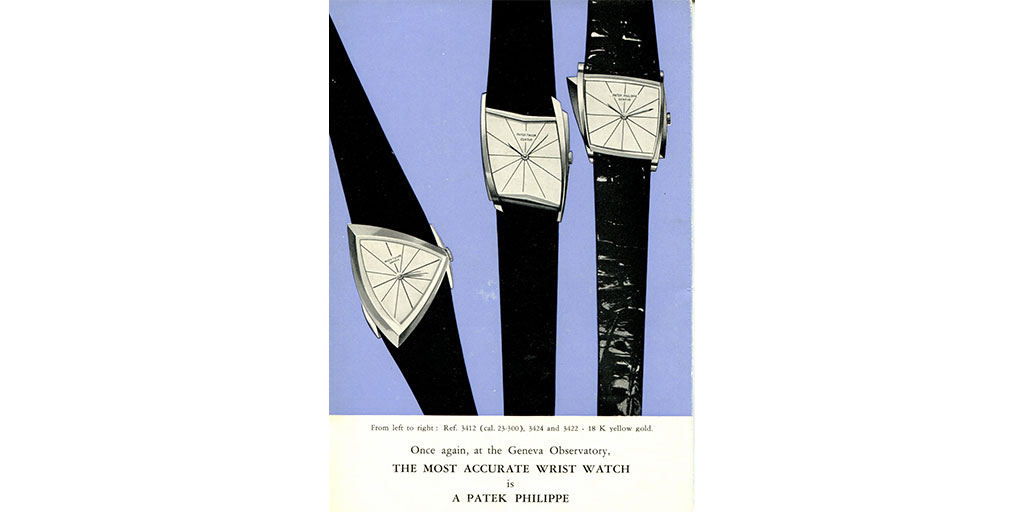
In 1955, at only 25 years of age he joined the Patek Philippe workshops and soon became the head of the creative department. At this time, Patek Philippe was under the adventurous guidance of Henri Stern, himself a talented artist who took something of a gamble nurturing the avant-garde design sensibility of the young jewelry designer Albert. Yet during the fifties, Patek was making more jewelry watches for women and Henri Stern felt it was time the firm built upon its skills as a jeweler. Furthermore, this was the golden age of commercial air travel and the jet-set looked to move away from the conventional towards more modern, innovative design. Henri Stern was very much part of this dynamic generation and, as with his successors, was focused on the future while still preserving the traditional craft of watchmaking.

Gilbert Albert completely re-invented the way that Patek Philippe and other companies looked at watch design. A watch case was no longer round or rectangle, but asymmetrical and triangle. Not even the pocket watch remained unchanged and designs such as ‘Ricochet’ brought this elderly statesman firmly into the Swinging Sixties. Henri Stern’s gamble soon paid off and by 1960, Patek Philippe had won the Grand Slam of the most coveted awards in the world of watch design: for three consecutive years from 1958, Patek Philippe was awarded the Diamonds International Award. Gilbert Albert would later go on to win this Oscar of the design world an unprecedented ten times.
In the eight years that Albert worked for Patek, his design output was prolific, although not all were put into production because of the uncertainty of their commercial success, and many stayed in the prototype stage. It’s perhaps hard for us to appreciate now, but convincing retailers to purchase and sell these avant-garde pieces was no easy task. Yes, people would line up at Basel to view these never-before-seen designs, however, assuring a conservative retailer of sell-through was another thing. This situation was not too dissimilar from the launch of the Nautilus in 1977, when many retailers, especially in the USA literally thought that Patek had “lost its mind” to quote a senior sales executive at the company during the 1970s. As so often with Patek Philippe, its designs were ahead of their time.
During the late 1950s and early 60s, Gilbert Albert introduced three main collections of pocket and pendant watches: the “Golf”, “Ricochet” and “Futuriste”. Within each of these series were numerous versions with variations on dials, finishes and shapes. The “Futuriste” series with nicknames such as “Flying saucer” and “Television”, plus pieces with shapes such as “Meteorite” and “Fossilised Leaf” remain some of the rarest. His eye for detail and unusual materials reinvented how people looked at watch design, and in some ways, how people wore watches.

The “Golf” watches, references 782 and 783 were launched in 1959 and still available in 1967. The ref. 782 was made in 18K yellow, rose and white gold; the two-piece 40 mm case was made by F. Baumgartner. Two other references in the “Golf” collection are refs. 785 and 799. Ref. 785 was produced from 1960 – 1964 in 18K yellow or rose gold, cases also made by F. Baumgartner.
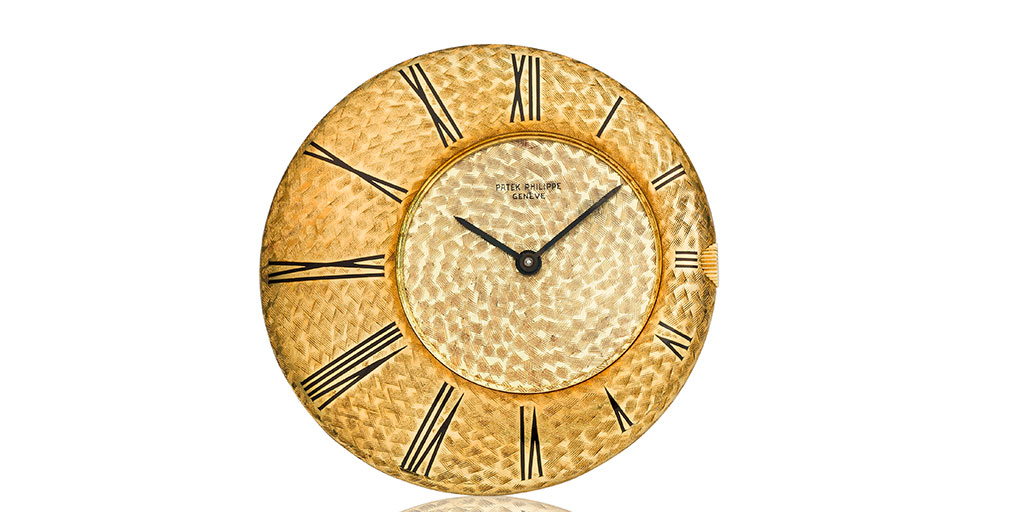
Gilbert Albert’s most famous and exciting collection is probably the “Ricochet” pocket and pendant watches which was influenced by both his love of nature and modern art. The asymmetrical and pebble-smooth cases are made from solid gold and he would hand-chisel and engrave each piece until they became an organic form that rests peacefully in the hand. These were not practical pieces but works of art. References 788 and 789 were produced approximately between 1961 – 1969. The two-piece case construction was by Antoine Gerlach and the dials by Stern Frères.
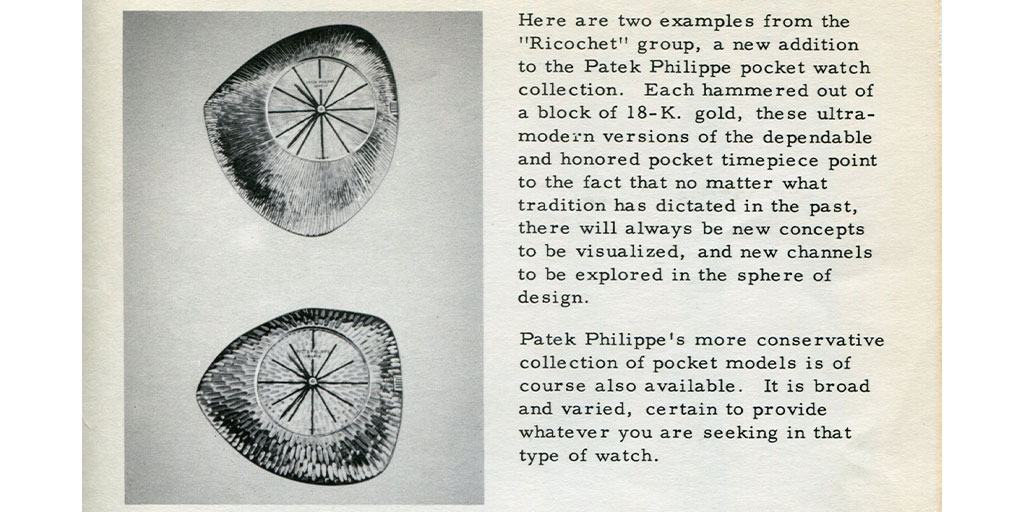
The “Flying Saucer” is almost as rare as its namesake. Part of the Ricochet collection, refs. 796 and 797 were made between 1961 – 1972. Today, only one 18K yellow gold and one platinum are known to have survived. Other rare “Flying Saucer” references include ref. 861 launched in 1965 and ref. 863 launched in 1966. The most likely “Flying Saucer” to be spotted is the ref. 855 which was first launched in the 1964 catalog celebrating Patek Philippe’s 125th Anniversary. Produced in three variations, several decorated with diamonds, the two-piece case was made by Eggly & Cie.
Rarer still are the one-of-a-kind “Futuriste” shapes, refs. 790 – 794 which were primarily pendant pieces with concealed dials. Each unique design shape was inspired by natural elements such as meteorites, minerals and fossils. Made between 1962 – 1967, none of these works of art have yet surfaced on the market and the only evidence of their existence is from archive pictures. Fortunately, not so rare is ref. 798. This cushion-shaped, ultra-thin pocket watch was produced from 1964 into the early 70s.

The iconic “Asymétrie” wristwatch collection launched in 1959 and produced through to the late 60s, included models for both men and women. The fact that these pieces were manufactured at all is because Henri Stern was seduced by their design — never had such a strange case housed a Patek wristwatch. The various triangular and rhomboid designs look as modern today as they did over 60 years ago, and they represent an important place in any watch collection.
Production of the ladies asymmetric collection was relatively short-lived from 1960 – 1961. To date, examples are only known in 18K yellow gold for ref. 3270 and the gold bracelet version ref. 3270-1. The cases were made by Markowski. To date, only one ref. 3270-1 and three ref. 3270 have appeared at auction.

The men’s asymmetric collection is anchored by the references 3412, 3413, 3422 and 3424. The ref. 3424 “Rhomboid 3” is regarded as the classic of all the rhomboid-inspired designs, and from its sensational launch at the Basel Fair in 1959, it still continues to attract attention. The bracelet and diamond versions refs. 3424-1 and 3424-2 are only known in a couple of examples of each configuration in platinum, 18K yellow and rose gold. The other three asymmetrical references 3412, 3413 and 3422 were produced in significantly lower quantities than the ref. 3424. This was in part because their avant-garde designs were not instantly a commercial success and were primarily made to order. The ref. 3412 “Triangle” was produced from 1958 – 1962 with approximately 12 made in 18K yellow gold with eight identified, and four in rose gold with three identified. Cases were by Markowski housing the caliber 23 300. Dials by Stern Frères. The ref. 3413 “Rhomboid 1” was only produced for two years: 1958 – 1959, and mostly to order.
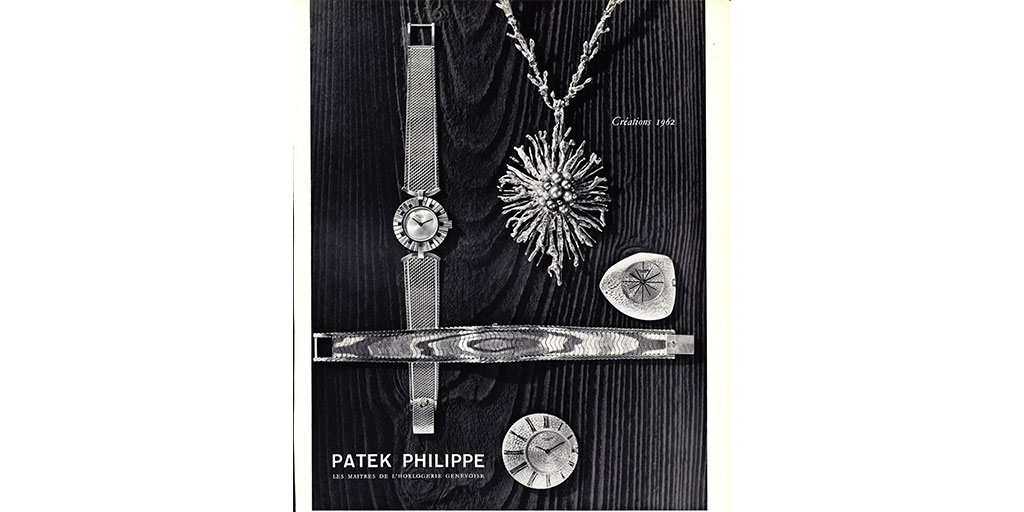
By the turn of the 1960s, Gilbert Albert was focusing on his true love, jewelry. Here his creativity knew no bounds, he would see beauty where no one else would. He reveled in using unusual materials such as meteorites and fossils, contrasting these rough materials with highly polished or textured gold, with a sprinkling of more traditional gemstones such as rubies, emeralds and diamonds. As always, he drew inspiration from nature: he would see a shell and see something precious to be replicated in a watch. He would see textures and lines in a meteorite and treat them in the same way as a precious stone. He even used fur to create straps. Such inspiration fueled an extraordinary array of jeweled watches and pendants, and traditional pieces of jewelry such as necklaces, bracelets and rings.
Gilbert Albert’s “Tutti Frutti” collection, anchored by references such as ref. 3086, 3289 and 3292 are some of the most sought-after pieces of his jeweled watch legacy at Patek Philippe. This collection continued to be made in the workshops until the late 1960s, several years after Gilbert Albert left Patek to start his own eponymous jewelry company in 1962. One of the most important jeweled timepieces that Albert made for Patek was ref. 3295 which won the prestigious 1960 Prix de la ville de Genève jewelry watch award at the Montres et Bijoux show. It is now on display at the Patek Philippe Museum. This “Tutti Fruitti” confection of tiny, multi-sized and various colors of gold elements were meticulously positioned like a mosaic to form the bracelet which conceals a delicate watch dial. Twelve pearls of various sizes and colors are exquisitely positioned around the bracelet. Truly elemental, the timepiece is something that a mermaid princess might wear, and it was equally worn and enjoyed by earthly royalty such as the great beauty Princess Marta zu Windisch-Graetz of Austria.
Gilbert Albert passed away on October 1, 2019 yet his legacy and impact on the world of watch and jewelry design continue to grow as new generations appreciate his unique contribution. Today, his is name is symbolic of some of the most beautiful designs the world has ever seen.

